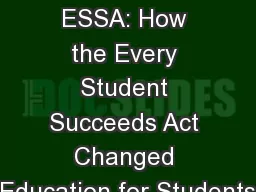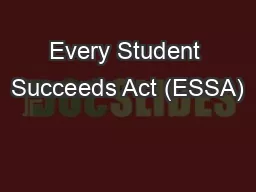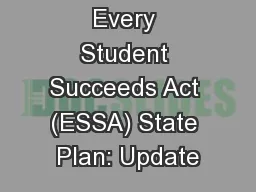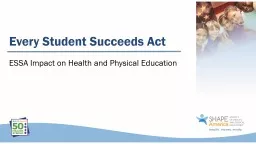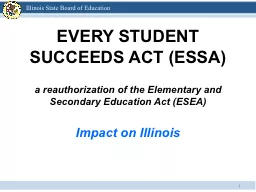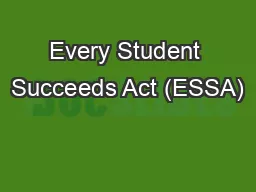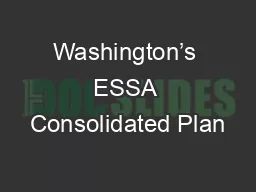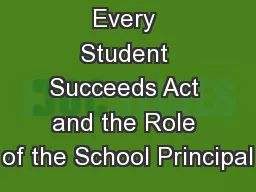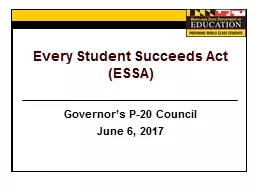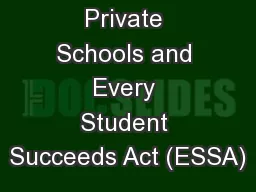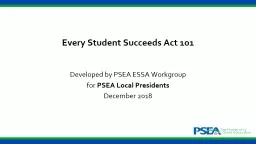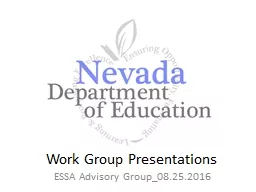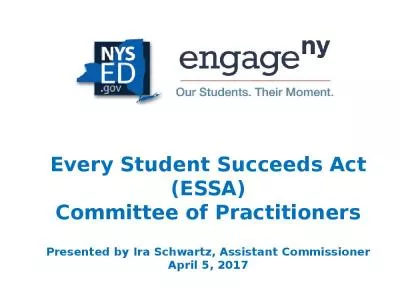PPT-All About ESSA: How the Every Student Succeeds Act Changed Education for Students
Author : debby-jeon | Published Date : 2018-10-25
Experiencing Homelessness Barbara Duffield SchoolHouse Connection Patricia Julianelle SchoolHouse Connection Christina Dukes National Center for Homeless Education
Presentation Embed Code
Download Presentation
Download Presentation The PPT/PDF document "All About ESSA: How the Every Student Su..." is the property of its rightful owner. Permission is granted to download and print the materials on this website for personal, non-commercial use only, and to display it on your personal computer provided you do not modify the materials and that you retain all copyright notices contained in the materials. By downloading content from our website, you accept the terms of this agreement.
All About ESSA: How the Every Student Succeeds Act Changed Education for Students: Transcript
Experiencing Homelessness Barbara Duffield SchoolHouse Connection Patricia Julianelle SchoolHouse Connection Christina Dukes National Center for Homeless Education Barbara Duffield. Students with Disabilities. The webinar will begin shortly.. For Audio: . . Select . the option to have Adobe call you, . or. . Dial 1.877.713.0446 | Conference . Code . 101 725 8988. #. Please . Board of Elementary and Secondary Education. March 22, 2016. 1965 – Initial Enactment (War on Poverty). Input focused: compensatory education . President Johnson. 1994 – . Improving America’s School Act . ESSA in Tennessee. Gallatin . Chamber of Commerce. Dr. Candice McQueen, Commissioner, . May 8, . 2017. Our Vision. Districts and schools in Tennessee will exemplify excellence and equity such that . all students . Presentation to the Board of Elementary and Secondary Education. August 15, 2017. Purpose of presentation. Provide an update to Board on status of Massachusetts’ state plan under federal Every Student Succeeds Act (ESSA). ESSA Impact on Health and Physical Education. new federal . education . law is passed!. 2002:. . No . Child Left . Behind . leaves. . health . and physical education . behind resulting in funding & program cuts. a reauthorization of the Elementary and Secondary Education Act (ESEA). Impact on Illinois. State of Illinois Goals for Education Reform. Improve Infrastructure and Alignment in Early Education:. ESSA includes significant alignment provisions, as well as continuation of the preschool development grant program. . Orientation. Presented . by Assistant Commissioner . Ira . Schwartz. Background Information. The . Elementary and Secondary Education Act (ESEA) was signed into law in 1965 by President Lyndon Baines Johnson, who believed that "full educational opportunity" should be "our first national goal." From its inception, ESEA was a civil rights law. Implementation 101. February 26, 2018. Zoom. 1. Starting with the Why…. 2. Every Student Succeeds Act. Pursuing Equity through Closing. Gaps. Continuous. Improvement for All Schools. Obtain and Retain Effective Educators. June 26, 2016. Presenter. Amanda Karhuse. Director of Advocacy, NASSP. About. The National Association of Secondary School Principals (NASSP) . is the leading organization of and voice for middle level and high school principals, assistant principals, and school leaders from across the United States and in over 35 countries around the world. Founded in 1916, NASSP's mission is to connect and engage school leaders through advocacy, research, education, and student programs.. Governor’s P-20 Council. June 6, . 2017. Highlights of Major Sections of the Law and Maryland’s Plan. Purpose. Timeline. Accountability. Support to Educators. Support to Students. 2. ESSA - Purpose. September 8, 2017. Russ Sweet. Interim Private School Ombudsman. Today’s Agenda. Introductions. Private School Regulations under Title I-A and Title VIII (Uniform Provisions). Oregon’s response to the regulations. Developed by PSEA ESSA Workgroup. for. PSEA Local Presidents. December 2018. What is ESSA?. ESSA = The . E. very . S. tudent . S. ucceeds . A. ct. ESSA at its core is a civil rights law.. ESSA is the 2015 reauthorization of the ESEA = . Work Group Presentations ESSA Advisory Group_08.25.2016 ESSA Assessment work group update Peter Zutz – Work Group Lead ESSA Assessment Workgroup Summary Meetings: #1 – 8/8/16; #2: 9/2/16; #3: TBD Committee of Practitioners. . Presented by Ira Schwartz, Assistant Commissioner. April 5, 2017. ESSA Update. ESSA Updates. The Every Student Succeeds Act (ESSA) remains in effect.. Rulemaking pertaining to the assessment provisions of ESSA are now...
Download Document
Here is the link to download the presentation.
"All About ESSA: How the Every Student Succeeds Act Changed Education for Students"The content belongs to its owner. You may download and print it for personal use, without modification, and keep all copyright notices. By downloading, you agree to these terms.
Related Documents

